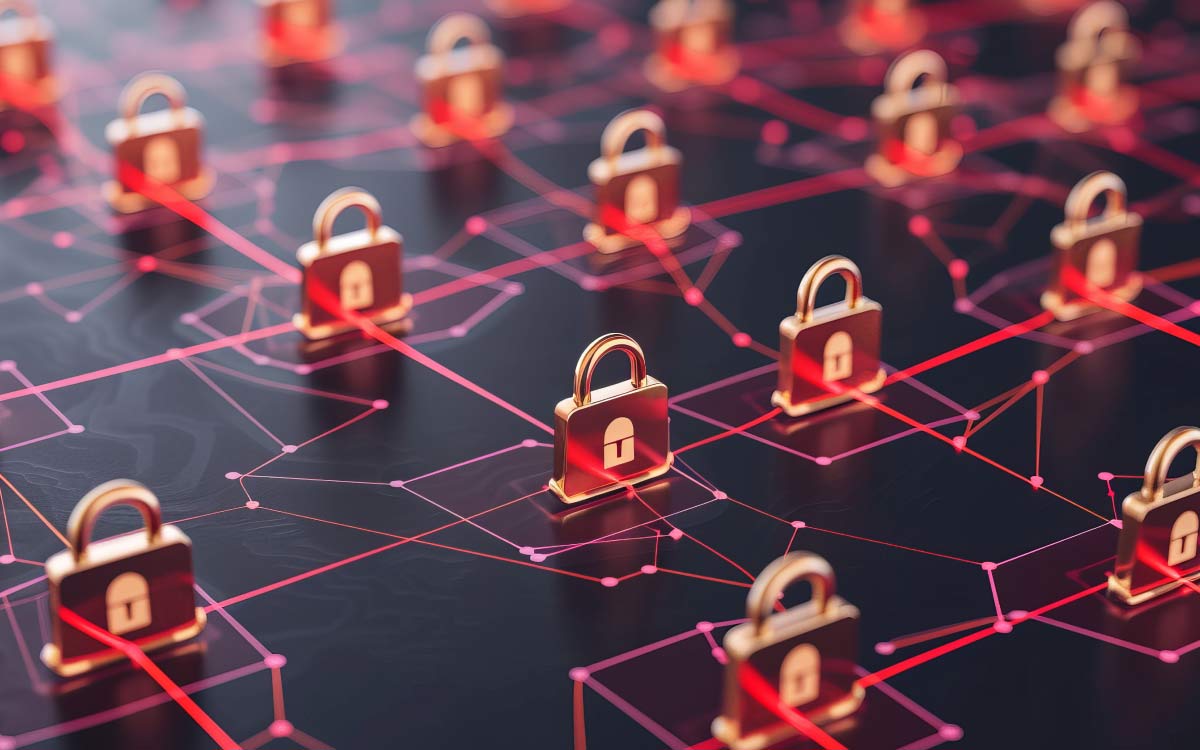You need end-to-end encryption to keep your data encrypted throughout the transmission process, from its origin point to its final destination. This article explores the topic of end-to-end encryption, including what it is, why it’s important, how it works, how it differs from other encryption methods, and its pros and cons. Also, for a more in-depth understanding of this concept, you can join a cybersecurity bootcamp.
Now, let’s dive right into what is end-to-end encryption.
What is End-to-End Encryption?
End-to-end encryption (E2EE) is a secure communication process that encrypts data before transmitting it to another endpoint while hiding the information from intermediaries, such as mail service providers. The data remains encrypted in transit and decrypted on the recipient’s device, not in the cloud. That’s because only the sender and recipient have the encrypt/decrypt keys to decipher the message. SMS, messaging apps, and other communications services use E2EE to protect their messages from unauthorized access.
As a result, cybercriminals monitoring Internet traffic or breaching a server can’t access the user’s data.
Also Read: Cybersecurity Certification Roadmap: An Ultimate Guide
What Kind of Encryption Does E2EE Use?
End-to-end encryption employs a specialized form of encryption known as public key (sometimes called asymmetric encryption). Public key encryption lets two parties communicate without sending the confidential decoding key over an insecure channel.
Public key encryption employs two keys: a public and a private key. Anyone, including the messaging service, can see the public key, but only one person knows the private key. So, data encrypted with a public key can only be decrypted with a private key. This differs from symmetric encryption, where one key is used for encryption and decryption.
Why Is End-to-End Encryption Important?
EE2 is a security method that keeps data communications secure. When using end-to-end encryption, no one, even Google or third parties, can read the encoded eligible messages as they move between your smartphone and the device you send the message to.
What is End-to-End Encryption, and How is It Used?
EE2 has many uses, including:
Data Storage
Storage devices typically provide E2EE at rest to guarantee that all data stored on the device stays encrypted and secure. Service providers sometimes offer E2EE in transit in a cloud storage situation to safeguard their customers’ sensitive data from anyone, including the cloud service provider. The dual approach ensures data is kept safe, whether stored or transmitted.
File Sharing
Legal, business, and personal files usually contain critical, sensitive data that could pose severe liabilities if it fell into the wrong hands. E2EE helps ensure unauthorized parties can’t access these personal files during transmission. Typical uses include encrypted cloud storage, peer-to-peer (P2P) file sharing, and specialized file transfer services.
Password Management
Several popular password managers, such as 1Password, Bitwarden, Dashlane, and LastPass, use E2EE to protect users’ passwords. However, unlike messaging services, these password providers don’t involve a second party. The user is the only person with the encryption key, and E2EE protects the password data when syncing between devices.
Secure Communications
E2EE is most commonly used for secure communications on mobile and online messaging platforms. These messenger apps employ E2EE to ensure that only the sender and receiver can read the messages—not even the service providers. Apple uses E2EE for its iMessage app, but Android leaves it to the discretion of the individual app developers. Plenty of messaging apps on the Google Play Store offer E2EE.
Also Read: 10 Best Cybersecurity Courses to Boost Your Skills in 2025
How Does End-to-End Encryption Work?
E2EE typically consists of these four steps:
- Encryption
- Transmission
- Decryption
- Authentication
- Encryption. E2EE starts by encrypting sensitive data using an encryption algorithm. This algorithm employs complex mathematical functions that scramble the data into an unreadable format called ciphertext. Authorized users with a secret key, called the decryption key, can only read the messages.
E2EE can employ an asymmetric encryption scheme that uses two different keys to encrypt/decrypt data or a symmetric encryption plan using only a single shared key. Many E2EE implementations even use a combination of the two.
- Transmission. Encrypted data (or ciphertext) moves over a communication channel such as the Internet or another network. The message remains unreadable to everyone, whether they’re application servers, internet service providers (ISPs), hackers, or other parties, as it travels to its destination. It appears as a series of random, unintelligible characters to anyone who intercepts it.
- Decryption. Once it reaches the recipient’s device, the ciphertext is decrypted with the recipient’s private key (if it’s asymmetric encryption) or the shared key (if it’s symmetric encryption). Only the recipient has the private key necessary for data decryption.
- Authentication. Decrypted data is then verified to ensure integrity and authenticity. This might involve verifying the sender’s digital signature or other online credentials to confirm that no one interfered with the data during transmission.
How Does End-to-End Encryption Differ from Other Encryption Practices?
E2EE uses cryptography to change readable plaintext into unreadable ciphertext like other encryption methods. This process helps mask sensitive information from unauthorized users and ensures that only the intended recipients can access the personal data, provided they have the correct decryption key.
However, unlike other encryption methods, E2EE provides data security from start to finish. E2EEv encrypts the data on the sender’s device, which stays encrypted during transmission, and then decrypts the information only when it reaches the recipient’s endpoint. This operation ensures that service/host providers can’t access the messages, only the sender and the intended recipient.
In contrast, encryption in transit secures data only while it’s moving between endpoints. For instance, Transport Layer Security (or TLS) encryption protocol encrypts the data as it travels between the client and the server. However, it doesn’t provide any meaningful protection against intermediary access, such as application servers or network providers.
Standard encryption in transit is usually more efficient, but many users are wary of the risks involved with service providers accessing their sensitive data. In these situations, any exposure, even at the endpoint level, could seriously threaten data privacy and overall security integrity.
Also Read: AI in Cybersecurity: Unlocking Smarter, Stronger Online Security
How Does End-to-End Encryption Support Privacy?
E2EE ensures no one can see messages except for the two parties communicating, provided that the devices they’re using aren’t compromised or stolen. When appropriately implemented, E2EE does not require users to hope that a service handles their data properly. So, E2EE gives people total control over who can read their messages, thus ensuring privacy.
The Advantages and Disadvantages of End-to-End Encryption
E2EE comes with its set of pros and cons. For instance:
Pros
- Offering data integrity and tamper resistance. In addition to encrypting data, most E2EE systems employ cryptographic methods to “sign” a document, vouching for its integrity. This “signature” consists of numbers confirming the sender’s identity, as only the sender has the private key that created the signature in the first place. In addition, the signature also has the result of a mathematical calculation of the data contents. If even a single character changes, the result of the mathematical computation changes. Thus, the recipient is assured that the data wasn’t tampered with since the sender created it.
- Protecting data against security compromises involving transmission, servers, and data centers. The most brutal cyber-attacks typically occur when a compromised server allows the attacker to access all the stored information. Thus, entire organizations or even multiple organizations can be compromised with just one attack. However, with E2EE, data is encrypted from when it leaves the sender’s device to when it’s received by the recipient, making it indecipherable between these points. So, E2EE offers excellent protection against the worst data breaches.
- Providing regulatory compliance. Many industries face increasing cybersecurity compliance regulations to combat ever-escalating threats. Personally Identifiable Information (PII) must be protected in a number of different industries — from education to health care (as codified in HIPAA regulations, for example). Some of the most stringent regulations pertain to national defense.
Cons
- Access patterns and metadata. While servers using E2EE can’t decrypt user data, meaning the attacker penetrating the server can’t directly “see” the data, a server breach may reveal access patterns that an attacker can exploit. For instance, the server recognizes the senders and recipients of messages and their corresponding e-mail addresses, known as Metadata. But sometimes, knowing that user A communicated with user B at time T can be valuable to an attacker, and even E2EE can’t stop this information from being leaked during a server attack.
- Limited accessibility for law enforcement. In systems that don’t employ E2EE, law enforcement can compel a server’s owner, possibly an email provider, to disclose information contained on the server. But with E2EE, all that data on the server is encrypted, so the service provider doesn’t have the means to decrypt the data. So, law enforcement must resort to methods typically reserved for physical objects and compelling the data owner to provide them.
- Vulnerability at compromised endpoints. Although E2EE can protect against many devastating attacks, such as server breaches, data can still be unencrypted on a user’s device for who knows how long. So, an attacker who breaches that device can access its data.
Also Read: What is Social Engineering, and How Do You Identify It?
Do You Want Cybersecurity Skills?
Knowing what is end-to-end encryption is just a small slice of cybersecurity skills. There’s a whole ecosystem of tools, protocols, and practices that work together to safeguard data and systems. To build your career in cybersecurity, you need to master key concepts and learn to apply them to real-world scenarios.
If you want to join the ranks of professionals who protect data integrity and fight back against cybercriminals, get started with this cybersecurity program. This six-month course provides training in both offensive and defensive cybersecurity methods. It alls teaches you about digital forensics, network security, and more, preparing you for one of the world’s most rapidly growing industries.
Cybersecurity is a fast-growing field with impressive earning potential – $132,136 per year, according to Talent.com. So, whether you’re looking to upskill at your current job or making a career switch into cybersecurity, consider this highly informative bootcamp.
FAQs
Q: What is meant by end-to-end encryption?
A: End-to-end encryption (or E2EE for short) is a secure communication process which encrypts your data before sending it to another endpoint.
Q: Is it good to turn on end-to-end encryption?
A: Yes, if you want to keep your data secure at all points from start to finish.
Q: What happens if I turn off end-to-end encryption?
A: You run the risk of having your information read by unauthorized third parties during transmission.
Q: Who needs end-to-end encryption?
A: Anyone who sends sensitive information and anyone who wants their files and privacy preserved during transmission.
Q: What is the benefit of end-to-end encryption?
A: End-to-end encryption’s benefits include:
- Data integrity and tamper resistance
- Protection against transmission compromises
- Enhanced regulatory compliance
You might also like to read:
Cybersecurity vs. Data Science: Navigating the Digital Future
Cybersecurity Essentials: What is a Security Operations Center?
What is Cyber Hygiene? Meeting Cybercriminals on the Front Lines






